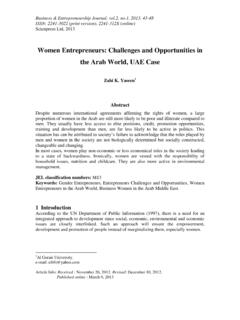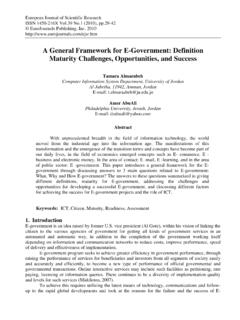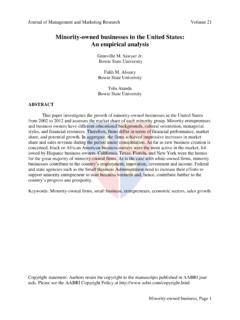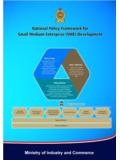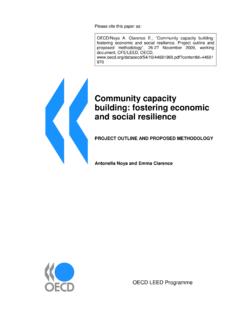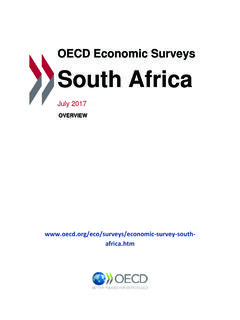Transcription of Female Entrepreneurship: Program Guidelines and Case …
1 Female entrepreneurship : Program Guidelines and Case Studies Female -run enterprises are steadily growing all over the world, contributing to household incomes and growth of national economies. However, women face time, human, physical, and social constraints that limit their ability to grow their businesses. The Resource Point on Female entrepreneurship responds to increasing demands for best practices and tools to integrate gender in private sector development and entrepreneurship promotion programs , and address the needs and constraints faced by Female entrepreneurs. It is designed to have two functions provide practical guidance and recommendations, and serve as a clearinghouse of programs , emerging research and data on the topic. The Resource Point includes: How to modules: Tools for Operations: Guidelines for integrating gender in training, access to finance and ICT programs , recommendations for designing gender-sensitive M&E.
2 Frameworks and including gender in impact evaluations, and links to relevant information and tools. Data Modules: Guidance for collecting gender-sensitive data on entrepreneurship . Warehouse modules: Research: Links to research on Female entrepreneurship . Database: Search engines for programs by country, region, approach used, and target population/beneficiaries. 1. Tools for operations The modules included in this section are designed to help task teams identify and address issues that limit women's entrepreneurship opportunities. Module 1 describes the main constraints faced by women entrepreneurs and recommends a number of actions that support the integration of gender during project identification and design. Module 2 contains practical recommendations to guide the implementation of business development, access to finance and ICT projects.
3 The module includes over 40 case studies of projects implemented by the World Bank and external organizations. Module 3 guides the task team in the design of a gender-informed monitoring and evaluation system. Module 4 focuses on the scope, rationale and implications for integrating gender in impact evaluations and presents some of the most recent findings from impact evaluations in this area. 2. Module 1: Identifying Gender-Specific Constraints to entrepreneurship Understanding the challenges and critical needs of Female entrepreneurs during project identification and preparation is important when designing a gender-informed operation. This module begins with identification of the constraints to women's entrepreneurship , followed by recommendations, in Part 2, to support the integration of gender at this stage.
4 Part 1: entrepreneurship Why Gender Matters Female entrepreneurs make significant contributions to economic growth and to poverty reduction. In the United States, for example, women-owned firms are growing at more than double the rate of all other firms, contribute nearly $3 trillion to the economy and are directly responsible for 23 million jobs. In developing countries, Female entrepreneurship is also increasing there are about 8 to 10 million formal SMEs with at least one woman While the number of women operating their own business is increasing globally, research shows that different factors are driving this trend. In developed countries, opportunity is the driving factor. In developing countries, however, entrepreneurship comes about largely due to necessity.
5 In the absence of other viable alternatives to provide for or supplement household incomes, entrepreneurship or self-employment is the only viable Further, Female owned businesses are characterized by low capital requirements, low barriers to entry, low income and largely concentrated in the service sector (see table 1). 1 US Department of Commerce (2010) Women-Owned Businesses in the 21st Century , prepared by the US. Department of Commerce, Economics and Statistics Administration for the White House Council on Women and Girls. 2 World Development Report 2012: Gender Equality and Development. 3. Table 1: General entrepreneurship and gender-specific constraints3. General entrepreneurship Area constraints Gender-specific constraints Human capital Lack of technical and business Lack of a combination of education, skills work experience, vocational and Occupational segregation technical skills Differences in endowments, preferences and barriers to entry and exit Selection of Lack of information and capital Overrepresentation in traditional Sector Barriers to entry and exit sectors that have low start-up costs including costs and capital and limited barriers to entry requirements Female entrepreneurs, especially Limited access to finance and those in informal enterprises.
6 Capital operate home-based businesses Access to Use of cheap technology resulting Lack or limited access to technology Information in high production costs and lack due to affordability, lack of of competition knowledge, and/or social norms Limited market opportunities Women more likely to start which leads to lower profits enterprise in sectors with low effective demand leading to lower profits Access to Limited access to finance due to Less favorable profile with investors Finance absence of financial markets, high since women own small businesses collateral requirements and and do not have adequate collateral interest rates, and additional bank Financial institutions may require charges higher collateral from Female Financial institutions reluctant to entrepreneurs.
7 Some banks may lend to MSMEs that are just also require women to have a male starting due to high risk involved co-signer in order to open accounts given their lack of financial record Low financial market participation Lack of financial products and Preference for own savings to services for MSMEs finance enterprises instead of credit from financial institutions 3 Sources: Aterido, Reyes; Thorsten Beck and Leonardo Iacovone. 2011. Gender and Finance in Sub-Saharan Africa: Are Women Disadvantaged? World Bank Policy Research Working Paper 5571; International Finance Corporation. 2011. Strengthening Access to Finance for Women SMEs in Developing Countries. Narain, Gender and Access to Finance. Analytical Paper, World Bank; and, Chamlou, Nadereh, 2007.
8 The Environment for Women's entrepreneurship in the Middle East and North Africa Region", Washington, DC. 4. General entrepreneurship Area constraints Gender-specific constraints Institutional Operating informal businesses Informality and home-based Factors Lack of business training leads to enterprises are mainly the result of a low productivity need to combine work and family responsibilities Limited vocational and technical skills may be caused by women's lower educational attainment or social norms that limit their physical mobility Policy/Legal Excessive bureaucracy and Limited knowledge of government regulations create additional legislation and less experience on costs and elongate length of time starting a business than men and to register and start a business compliance thus discouraged.
9 Men usually defined as head of Women more vulnerable to corrupt household and are legal owners officials of matrimonial property Denial or limited ability to own assets and inheritance due to laws Social/Cultural Low profits and growth Competing demands between norms Lack of mobility market and household work for time due to family responsibilities Limited Female labor market participation Mobility constraints Need for a male co-signer in financial documents. Female entrepreneurs are more likely to operate in the informal sector or in traditional Female sectors Worldwide, at least 30 percent of women in the non-agricultural labor force are self- employed in the informal sector; in Africa, this figure is 63 percent. Women-owned businesses tend to be informal, home-based and concentrated in the areas of small-scale entrepreneurship and traditional sectors, which primarily includes retail and service.
10 Operating from the home allows women to satisfy competing demands for their time caused by the disproportionate share of housework and childcare While working in a traditional sector requires less experience and lower start-up capital, the downside is that these sectors also offer lower returns. Social norms are also an important factor accounting for the high number of women entrepreneurs who operate in the informal sector. A qualitative study on gender and 4 Beneria, Lourdes (2001) "Changing Employment Patterns and Informalization of Jobs: Gender Trends and Gender Dimensions." International Labor Office (ILO), Geneva 5. economic choice in the 2012 World Development Report on Gender and Development found that, in all 19 countries studied, social norms are the most frequently reported constraint to physical mobility, followed by public Networks play an important role in helping entrepreneurs gain advice, form partnerships, secure financing, and access qualified management and employees.










